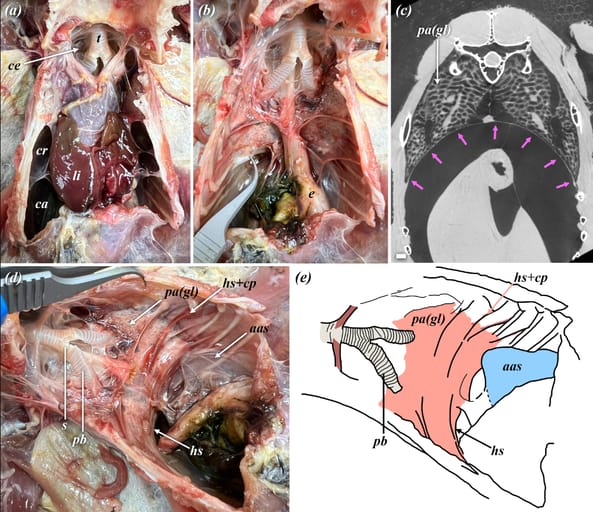- Veterinary View Box
- Posts
- What Makes a Bird Lung Unique? New Insights into Avian Respiration
What Makes a Bird Lung Unique? New Insights into Avian Respiration
Philosophical Transactions of the Royal Society B (2025)
Emma R. Schachner, Andrew J. Moore
Background
The avian respiratory system is highly specialized, featuring a functionally decoupled gas-exchanging lung and ventilatory air sacs, a trait that differentiates birds from other sauropsids. While unidirectional airflow and post-cranial skeletal pneumaticity have been studied in both birds and their extinct relatives, the role of the horizontal septum in maintaining a rigid, isovolumetric lung remains underexplored. This review examines the structural and functional adaptations of the avian lung, integrating comparative anatomical data from multiple bird species and non-avian archosaurs to address longstanding evolutionary questions.
Methods
The study used three-dimensional imaging, digital anatomical models, and traditional dissection to analyze the pulmonary systems of several bird species, including the red-tailed hawk, common ostrich, barred owl, African grey parrot, and zebra finch. Comparative data from non-avian sauropsids, such as crocodilians, were also examined to evaluate anatomical homologies. The study reviewed existing literature on bronchial tree morphology, air sac function, and respiratory mechanisms to refine our understanding of how the avian lung evolved.
Results
The findings confirm that the immobility of the gas-exchanging lung, enforced by the horizontal septum, is a key feature distinguishing birds from other sauropsids. This septum prevents lung collapse and facilitates efficient cross-current gas exchange. The study also highlights anatomical variability in air sac morphology across species, revealing previously undocumented structural differences. Notably, the presence of post-cranial skeletal pneumaticity alone does not confirm a fully avian lung in extinct ornithodirans (pterosaurs and non-avian dinosaurs), as the horizontal septum is a necessary prerequisite for a functionally decoupled respiratory system.
Limitations
While this review synthesizes extensive anatomical and imaging data, it remains largely qualitative. Further quantitative studies are needed to assess the biomechanical role of the horizontal septum and its evolutionary implications. Additionally, the functional significance of air sac variation across avian taxa requires further investigation.
Conclusions
The horizontal septum plays a crucial role in avian lung function and should be considered essential for reconstructing respiratory systems in extinct species. While unidirectional airflow and skeletal pneumaticity are not unique to birds, the complete functional decoupling of the lung and air sacs appears to be an avian innovation. These findings challenge previous assumptions about the respiratory anatomy of non-avian dinosaurs and highlight the need for further research on pulmonary evolution in vertebrates.

Anatomy of the horizontal septum in the barred owl (S. varia). (a) Coelomic cavity of S. varia in ventral view with the pericardium, liver, trachea and ruptured interclavicular, cranial thoracic and caudal thoracic air sacs exposed. (b) Viscera have been removed exposing the ventral surface of the gas-exchanging lung and horizontal septum (gripped by tweezers). (c) µCT image of an adult S. varia gas-exchanging lung demonstrating the horizontal septum (indicated by the pink arrows); scale bar = 1 cm. (d) Gas-exchanging lung shown in oblique ventrolateral view, demonstrating the horizontal septum, the lung hilus, its attachment to the medial aspect of the dorsal ribs, along with the left abdominal air sac extending through the opening in the septum into the coelomic cavity with the abdominal viscera. (e) Diagrammatic illustration of (d). Abbreviations: aas, abdominal air sac; ca, caudal thoracic air sac; cp, costopulmonales muscles; ce, cervical air sac; cr, cranial thoracic air sac; e, esophagus; hs, horizontal septum; li, liver; pa(gl), parabronchi (gas-exchanging lung); pb, primary bronchus; t, trachea.
How did we do? |
Disclaimer: The summary generated in this email was created by an AI large language model. Therefore errors may occur. Reading the article is the best way to understand the scholarly work. The figure presented here remains the property of the publisher or author and subject to the applicable copyright agreement. It is reproduced here as an educational work. If you have any questions or concerns about the work presented here, reply to this email.